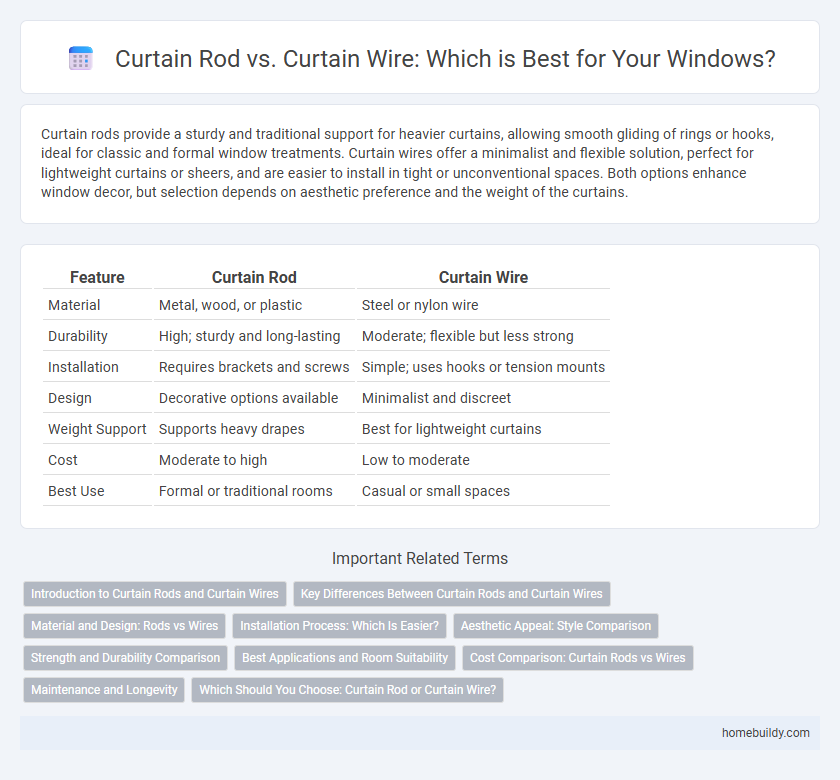Curtain rods provide a sturdy and traditional support for heavier curtains, allowing smooth gliding of rings or hooks, ideal for classic and formal window treatments. Curtain wires offer a minimalist and flexible solution, perfect for lightweight curtains or sheers, and are easier to install in tight or unconventional spaces. Both options enhance window decor, but selection depends on aesthetic preference and the weight of the curtains.
Table of Comparison
| Feature | Curtain Rod | Curtain Wire |
|---|---|---|
| Material | Metal, wood, or plastic | Steel or nylon wire |
| Durability | High; sturdy and long-lasting | Moderate; flexible but less strong |
| Installation | Requires brackets and screws | Simple; uses hooks or tension mounts |
| Design | Decorative options available | Minimalist and discreet |
| Weight Support | Supports heavy drapes | Best for lightweight curtains |
| Cost | Moderate to high | Low to moderate |
| Best Use | Formal or traditional rooms | Casual or small spaces |
Introduction to Curtain Rods and Curtain Wires
Curtain rods are sturdy, cylindrical bars made from materials like metal or wood, designed to support heavier curtains and provide a classic, polished look to window treatments. Curtain wires consist of flexible cables, often made of stainless steel, suitable for lightweight curtains and minimalist or modern decor styles, offering easy installation and versatility. Choosing between curtain rods and curtain wires depends on the weight of the curtains, desired aesthetic, and installation needs.
Key Differences Between Curtain Rods and Curtain Wires
Curtain rods are typically made of metal or wood and provide sturdy support for heavier curtains, while curtain wires consist of thin, flexible cables ideal for lightweight fabrics or minimalist designs. Curtain rods offer a more decorative appearance with various finial options, whereas curtain wires present a sleek, unobtrusive look that suits modern interiors. Installation methods differ as curtain rods require brackets mounted on walls, while curtain wires are attached with tension or wall anchors, making them easier to adjust or relocate.
Material and Design: Rods vs Wires
Curtain rods are typically made from sturdy materials such as metal, wood, or durable plastic, offering rigid support and a classic cylindrical design ideal for heavier drapes and traditional window treatments. Curtain wires, often composed of stainless steel or nylon-coated wire, provide a flexible, minimalist look suitable for lightweight curtains and modern, sleek aesthetics. The solid construction of rods ensures stability and decorative finials, while wires emphasize adjustability and discreet installation.
Installation Process: Which Is Easier?
Curtain rods typically offer a more straightforward installation process, involving mounting brackets screwed into the wall and sliding the rod through curtain rings or grommets. Curtain wires require tensioning and secure anchoring at both ends, which can be more challenging to achieve a taut and stable setup. The simplicity of curtain rods makes them easier for most DIY users to install quickly and accurately.
Aesthetic Appeal: Style Comparison
Curtain rods offer a classic and polished aesthetic, enhancing traditional or modern interiors with their solid, defined structure and variety of finishes such as brushed nickel, bronze, or matte black. Curtain wires provide a minimalist and sleek look, ideal for contemporary spaces, allowing curtains to appear as if they are floating with thin, almost invisible support. The choice between curtain rods and wires significantly impacts room style, with rods emphasizing elegance and wires promoting subtlety and openness.
Strength and Durability Comparison
Curtain rods offer superior strength and durability compared to curtain wires, as they are typically made from robust metals like steel or aluminum designed to hold heavier curtains without bending or sagging. Curtain wires, often constructed from thin steel cables, may lack the rigidity required for heavier fabrics, leading to potential sagging or damage over time. For long-lasting support and stability, especially with heavy or thick curtains, curtain rods provide a more reliable and sturdy solution.
Best Applications and Room Suitability
Curtain rods offer sturdy support ideal for heavy drapes and structured window treatments in living rooms, bedrooms, and formal spaces. Curtain wires provide a minimalist, flexible solution perfect for lightweight fabrics, small windows, or irregular wall shapes in kitchens, bathrooms, and modern apartments. Selecting between curtain rods and wires depends on fabric weight, mounting surface, and desired aesthetic impact.
Cost Comparison: Curtain Rods vs Wires
Curtain rods typically cost more than curtain wires due to their increased material thickness and decorative finishes, with prices ranging from $15 to $100 or more depending on design and length. Curtain wires are usually more affordable, often priced between $10 and $30, making them a budget-friendly option for lightweight curtains or minimalist aesthetics. Installation costs for rods can be higher as they require brackets and more precise mounting, whereas curtain wires offer simpler setups that reduce labor expenses.
Maintenance and Longevity
Curtain rods typically require less maintenance than curtain wires due to their sturdier construction and resistance to bending or sagging. Steel or aluminum rods offer enhanced durability and can support heavier curtains without frequent adjustments. Curtain wires, often made of thin steel cable, may need regular tensioning and are more prone to wear, reducing their longevity compared to solid rods.
Which Should You Choose: Curtain Rod or Curtain Wire?
Curtain rods offer sturdy support for heavier fabrics and create a traditional, elegant look, while curtain wires provide a minimalist, flexible option ideal for lightweight or sheer curtains. Choose a curtain rod for durability and decorative finials, especially in classic or formal interiors, whereas curtain wire suits modern, compact spaces requiring discreet window treatments. Consider the weight of your curtains, installation ease, and aesthetic preferences to select the best solution for your window design.
Curtain rod vs Curtain wire Infographic

 homebuildy.com
homebuildy.com